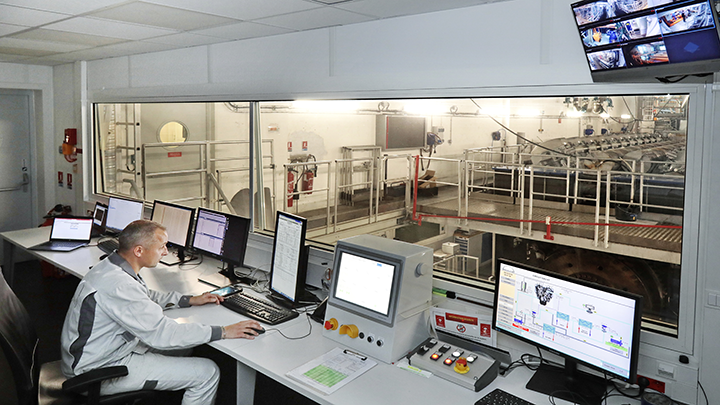MAN’s Multi Fluid Monitor Detects Contamination, Prevents Failure
David Valette of MAN Energy Solutions says its Multi Fluid Monitor works in tandem with laboratory oil analysis and traditional detection systems.
Turbomachinery International spoke with MAN Energy Solution’s David Valette, Regional Sales Manager – Americas, about the company’s recent update to its 2020 oil-monitoring platform: the Multi Fluid Monitor (MFM). Valette provided deep market and technical insight into the MFM platform and dove into its detection capabilities, synchronicity with other monitoring methods, typical use cases, and much more.
Operator using MFM to monitor MAN 51/60G engine; image credit: MAN Energy Solutions

TURBO: How does the MFM detect anomalies within engine oil?
Valette: The MFM is comprised of two sensors and an advanced patented algorithm that allows the detection of various anomalies, such as contamination, degradation, and wear of engine components. In a few seconds, the MFM will be able to detect water contamination, fuel contamination, soot combustion contamination, and the presence of ferrous and non-ferrous particles.
By analyzing the contamination’s speed and pervasiveness, the MFM will recommend the proper maintenance operations for the operator and/or will recommend stopping the engine to prevent any minor/major failure. The technology also addresses the constraints of modern engines, which run on diesel or gas and low-carbon fuels, such as methanol and ammonia. It can easily detect the dilution of these fuels in the oil, which is a critical factor for engine reliability and maintenance.
TURBO: What are the advantages of real-time, continuous monitoring of engine oil conditions over traditional oil-mist systems?
Valette: Unlike traditional laboratory oil analysis, which is performed at periodic intervals (sometimes weeks apart), the MFM provides instant and continuous insight into oil health. This enables the early detection of anomalies, preventing costly failures; however, these methods are complementary. Laboratory analyses allow for extremely detailed microscopic investigations that are difficult to achieve with onboard sensors, while the MFM provides a macroscopic real-time analysis, enabling continuous and proactive monitoring.
Additionally, our system complements traditional oil mist detection systems. While oil mist detectors analyze the presence of hazardous gases in the crankcase, MFM identifies their origin and root cause, offering a more comprehensive engine diagnostic approach.
TURBO: How can smart engine oil monitoring promote predictive maintenance over reactive maintenance?
Valette: MFM enables the early detection of engine component degradation and oil contamination, allowing operators to schedule maintenance interventions based on the severity of the identified anomaly. Based on real-time data, this predictive approach helps extend component lifespan, reduce maintenance costs, and prevent unexpected breakdowns. These are key factors in ensuring the efficient and cost-effective operation of industrial engines.
TURBO: On the software side, is there a difference between monitoring four-stroke and two-stroke engines? If so, how does it vary?
Valette: Our software solutions are adapted to different engine applications to meet customer requirements. For example:
- A small high-speed four-stroke engine requires specific calibrations and diagnostic parameters.
- A medium-speed four-stroke industrial engine is monitored with optimized analysis parameters to ensure efficient long-term operation.
- A low-speed two-stroke engine requires additional adjustments, particularly in relation to the lubrication system, although the core hardware remains unchanged.
For several months, we have been developing new MFM versions with both hardware and software modifications to accommodate the unique challenges of two-stroke engines, particularly concerning scavenge air-oil draining (cylinder and piston lubrication). We are also working on dedicated applications for auxiliary engines, further expanding our monitoring capabilities.
TURBO: Can you discuss a specific use case for MAN Energy’s MFM? How did it prevent further oil degradation and save production?
Valette: During new engine assembly and maintenance operations conducted by our MAN technicians, we use MFM to validate the correct installation of all mechanical components, both in our test cells and at customer sites. Our MFM systems have allowed us to detect anomalies within the first minutes of engine operation, such as water contamination in the oil or abnormal mechanical wear. These may have resulted from internal leaks, unfavorable operating conditions, or assembly/break-in issues, respectively.
By detecting these anomalies early, we have been able to intervene promptly, prevent further oil degradation, and optimize engine reliability before commissioning. This proactive approach enhances safety, improves engine performance, and minimizes costly failures for our customers.